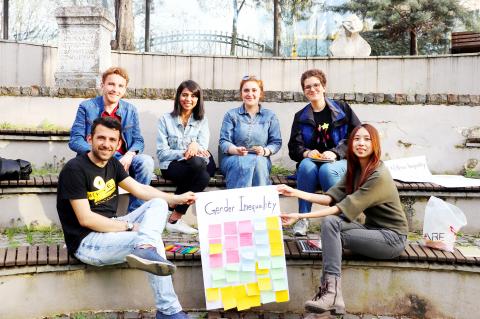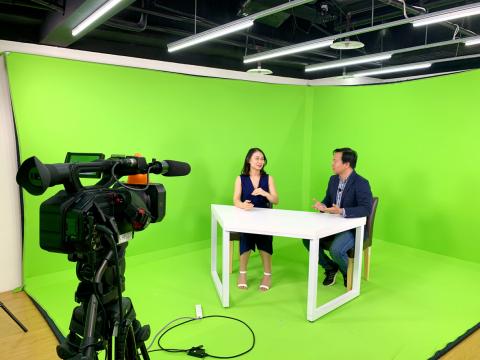When a group of Taiwanese students in Norway sued the Norwegian government last year for changing the nationality on their residency permits to China, they naturally engaged a lawyer to fight their legal battles. But to win over the court of public opinion, they would need a very different kind of representation.
Enter the Taiwan Digital Diplomacy Association (台灣數位外交協會, TDDA). Founder Kuo Chia-yo (郭家佑), 28, tells the Taipei Times that the group will be helping the Taiwanese students with their digital outreach this year. It’s one of several digital diplomacy projects the non-government organization has taken on since its establishment in 2017.
Using new digital tools and social media, coupled with old-fashioned cultural observation, TDDA is spearheading a unique approach to boost Taiwan’s profile on the global stage, and broaden the nation’s constrained space for international exchanges. Its work is also filling a notable gap in Taiwan’s official approach to public diplomacy.

Photo courtesy of Taiwan Digital Diplomacy Association
GRASSROOTS DIPLOMACY
“We’re not like a typical government project that goes out to promote Taiwan by saying we’re great or asking everyone to come check us out,” Kuo says. “Our approach is more like networking, to find things that we can do together with locals [of other countries] on social media.”
TDDA is a lean outfit, with only two full-time and eight part-time staff, but its reach is imaginative. Kuo, who now flits between Taipei and Ho Chi Minh City, has so far taken the organization to Kosovo and Vietnam.

Photo courtesy of Taiwan Digital Diplomacy Association
In Kosovo, a landlocked state in Southeastern Europe, Taiwan has a natural friend in the shared experience of being a country with only partial international recognition.
In 2017, TDDA ran a social media campaign advocating Kosovo’s digital independence by having its own national Internet domain. A video of young Taiwanese declaring their support for Kosovo attracted 32,000 views on Facebook, gaining precious traction for Taiwan in the nation of nearly two million.
Last summer, the group worked with the Kosovo Cultural Exchange Association to produce an exhibition on visions of Kosovo’s future at the national museum in the capital Pristina. The project involved Taiwanese designers and interactive digital exhibitions such as a “democracy wall,” where visitors voted for the social changes they most desired to see in Kosovo.
In Vietnam, TDDA has set up Taiwan Corner, a cafe and exhibition space, and produced an Internet medical talkshow series featuring a panel of Vietnamese doctors talking about medical issues that locals commonly face.
If the links to Taiwan seem indirect, that’s the intention. The idea is to earn Taiwan more friends and supporters by first showing a concern for causes that are important to the citizens of other countries.
For its projects in Vietnam, the organization has also worked closely with Vietnamese students in Taiwan, further strengthening offline, people-to-people ties between the two countries.
Kuo sees this as a way of forging connections that are more resilient to geopolitical power dynamics, especially in the face of growing Chinese pressure that has seen the number of Taiwan’s diplomatic allies fall to 15.
“When people really see you as a friend, they won’t cut you off just because of China,” Kuo says. “What will get cut off is government relations, but not people-to-people connections.”
SOCIAL MEDIA PROFILE
With the proliferation of social media and data-driven technologies, the use of digital diplomacy to win over hearts and minds abroad is a growing priority for foreign offices around the world.
In particular, digital diplomacy is proving to be an essential tool where there are no formal diplomatic ties. Israel’s Ministry of Foreign Affairs runs several Arabic-language social media platforms to reach out to the citizens of Arab countries with which the country does not have diplomatic relations.
The potential for Taiwan, which boasts a high Internet and smartphone penetration rate, is obvious. Yet there are still disparities between the government’s grasp of social media for domestic and international audiences.
While the government already leverages Facebook, Twitter, YouTube, LINE and local influencers for domestic messaging, digital diplomacy directed at the rest of the world has developed at a much slower pace.
The Ministry of Foreign Affairs only started a Twitter account in April 2018, and Kuo cites the fact that the country’s overseas representative offices have only recently started making their social media posts in English or the vernacular language.
Kosovo’s digital independence and the medical concerns of Vietnamese may seem remote from Taiwan’s international standing, but these are issues that TDDA landed on after building social media profiles of both countries. The objective is to identify causes that Taiwanese and citizens of that country can work on together, exchanging their shared values.
Kuo says that it takes the team several months to trawl through social media profiles, groups and hashtags to gain a feel for the preoccupations of their citizens and their impressions of Taiwan.
For example, TDDA conceptualized the medical talkshow after their efforts revealed that health is one of the top discussion topics for Vietnamese on social media, but that few think of Taiwan as a destination for medical tourism.
TDDA is still in the midst of building its digital strategy for the Taiwanese students’ lawsuit against Norway, but Kuo says that for a start, they plan to use Norwegians’ love of music to familiarize them with Taiwan.
These are skills that TDDA wants to impart to more young Taiwanese. At a digital diplomacy workshop in May last year, participants found that when it comes to Taiwan, East Asians concern themselves with the country’s tourism offerings and elections, Eastern and Southern Europeans think of restaurants and an air gun shop called Taiwan Gun, while Latin Americans have developed a taste for Taiwanese drama serials. Most Africans, however, have no impression of the country.
Such social media insights provide rare granular detail for understanding how Taiwan is perceived internationally.
Kuo still faces challenges in forging the local connections needed to get TDDA’s projects off the ground, and her own family’s inability to understand her unconventional career path. But she believes that the value of digital diplomacy will only strengthen for Taiwan’s future generations of digital natives.
“In the past they might have felt that diplomacy is something the government does and it has no connection to me. But now, because the channels that we use are social media, it’s something that everyone knows. So more people feel that actually, they can do something,” Kuo says.

This is the year that the demographic crisis will begin to impact people’s lives. This will create pressures on treatment and hiring of foreigners. Regardless of whatever technological breakthroughs happen, the real value will come from digesting and productively applying existing technologies in new and creative ways. INTRODUCING BASIC SERVICES BREAKDOWNS At some point soon, we will begin to witness a breakdown in basic services. Initially, it will be limited and sporadic, but the frequency and newsworthiness of the incidents will only continue to accelerate dramatically in the coming years. Here in central Taiwan, many basic services are severely understaffed, and

Jan. 5 to Jan. 11 Of the more than 3,000km of sugar railway that once criss-crossed central and southern Taiwan, just 16.1km remain in operation today. By the time Dafydd Fell began photographing the network in earnest in 1994, it was already well past its heyday. The system had been significantly cut back, leaving behind abandoned stations, rusting rolling stock and crumbling facilities. This reduction continued during the five years of his documentation, adding urgency to his task. As passenger services had already ceased by then, Fell had to wait for the sugarcane harvest season each year, which typically ran from

It is a soulful folk song, filled with feeling and history: A love-stricken young man tells God about his hopes and dreams of happiness. Generations of Uighurs, the Turkic ethnic minority in China’s Xinjiang region, have played it at parties and weddings. But today, if they download it, play it or share it online, they risk ending up in prison. Besh pede, a popular Uighur folk ballad, is among dozens of Uighur-language songs that have been deemed “problematic” by Xinjiang authorities, according to a recording of a meeting held by police and other local officials in the historic city of Kashgar in

It’s a good thing that 2025 is over. Yes, I fully expect we will look back on the year with nostalgia, once we have experienced this year and 2027. Traditionally at New Years much discourse is devoted to discussing what happened the previous year. Let’s have a look at what didn’t happen. Many bad things did not happen. The People’s Republic of China (PRC) did not attack Taiwan. We didn’t have a massive, destructive earthquake or drought. We didn’t have a major human pandemic. No widespread unemployment or other destructive social events. Nothing serious was done about Taiwan’s swelling birth rate catastrophe.